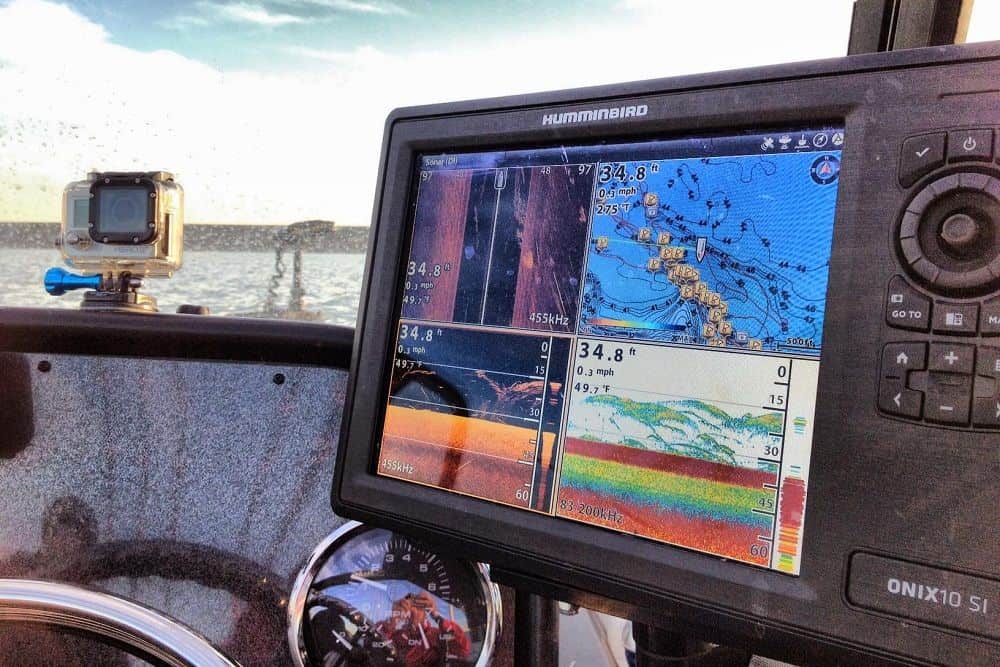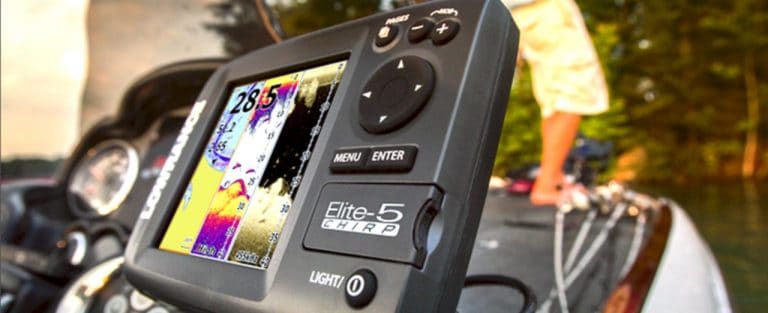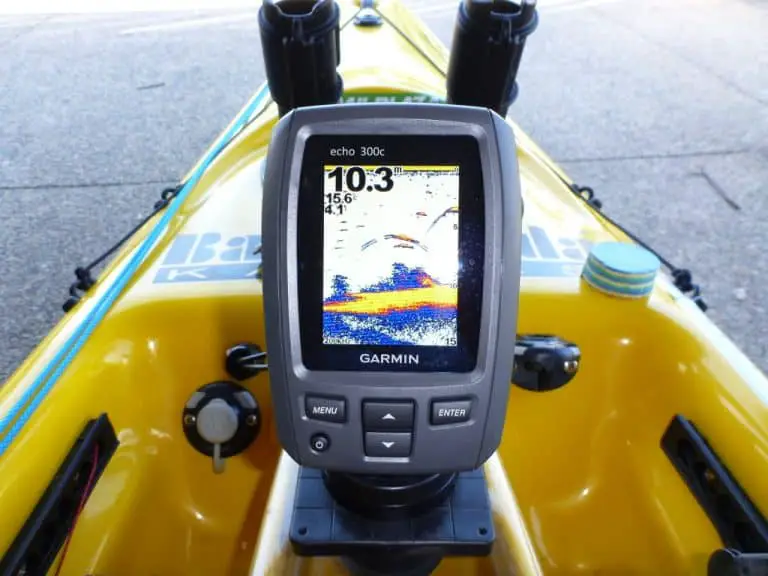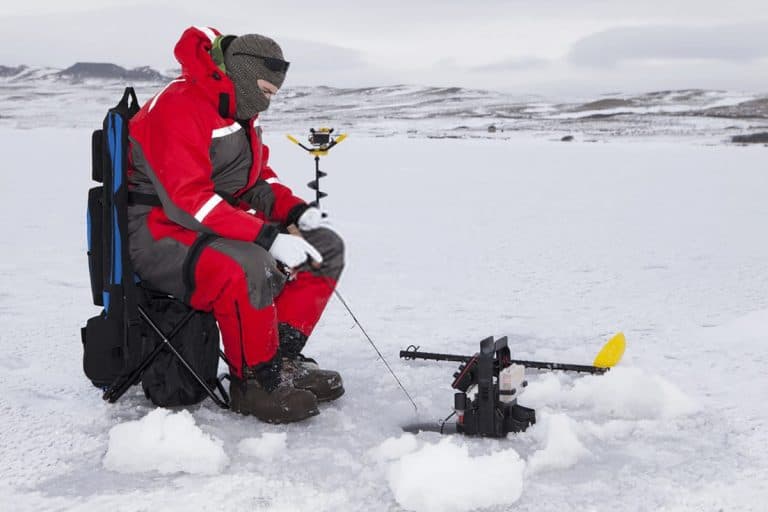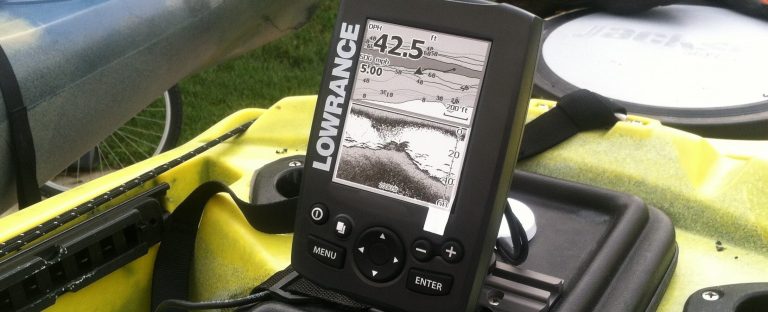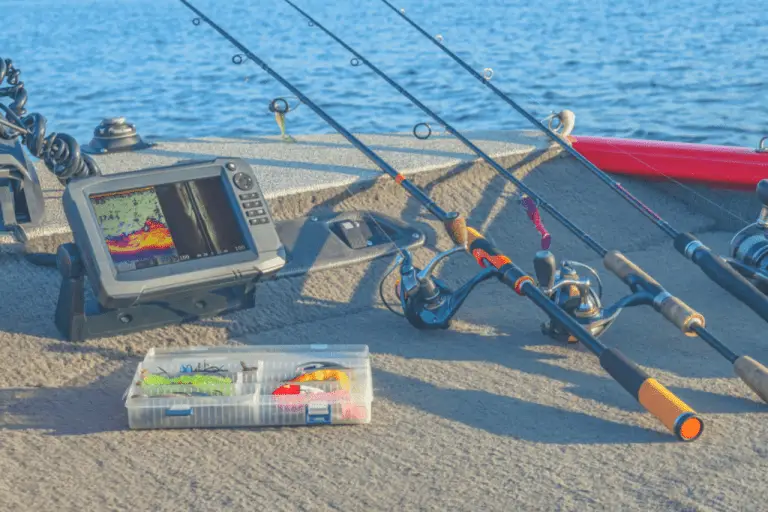Best Fish Finder GPS Combos in 2023 That Work Everywhere, Always
Why go through the hassle of reading complicated nautical charts or lose your sense of direction in blinding fogs when you can use a GPS fish finder?
Having an all-in-one device that serves as both a fish finder and a navigation aid is quite the advantage. On the market, you can hardly find a modern fish finder without an integrated GPS, yet they differ in what they offer. Due to the competition, products provided by different manufacturers have different capabilities.
Hence, we compiled the best fish finder GPS combos currently on the market and reviewed them, so you’d be able to weigh your options and choose according to your preferences.
Table of Contents
Fish Finder GPS Combos Comparison Table:
| Fish finder | Dimensions | Depth | Display | Frequency |
|---|---|---|---|---|
| Raymarine Dragonfly 7 Pro Chirp | 13.8 x 13.8 x 13.8-in. | 600 feet | 7-in. | 170-380 kHz |
| Humminbird 410210-1 Helix 5 G2 | 1.1 x 7.5 x 4.3-in. | 2500 feet | 5-in. | 50-200 kHz |
| Garmin Striker 4 | 3.6 x 5.9 x 1.6-in. | 1600 feet | 3.5-in. | 50-200 kHz |
| Deeper PRO+ Smart Sonar | 3 x 5.3 x 5.9-in. | 260 feet | Depending on Connected Device | 90-290 kHz |
| Simrad GO7 XSE | 9.26 x 5.95 x 3-in. | 1000 feet | 7-in. | 50-200 kHz |
| Lowrance Hook2 5 | 4.32 x 7.31 x 3.39-in. | 300 feet | 5-in. | 200-800 kHz |
| Garmin Striker 7SV | 9.3 x 5.5 x 2.3-in. | 2300 ft | 7-in. | 50-800 kHz |
The 7 Best Fish Finder GPS Combos in 2022
1. Raymarine Dragonfly 7 Pro CHIRP – Best GPS Fish Finder

For a device that features one of the quickest and most accurate GPS systems, we have nothing to say except that it deserves to be the best fish finder GPS combo on our list. This unit is a serious upgrade in the world of navigation, thanks to its 50 built-in channel high-precision GPS and Chartplotter.
What makes it more outstanding in this field is its Navionics mapping card that you can hardly find on other units. This card holds a list of up-to-date charts of more than 20000 lakes and almost all coastal waters in the US and Canada. As for the pleasure of saving your favorite fishing spots, the unit offers a memory that can save up to 3000 waypoints and 15 tracks.
Dragonfly comes with a CHIRP DownVision sonar, which offers superior bottom-tracking and image update from up to 600-foot depth. Its beam frequency ranges from 170 to 380 kHz. Add this to its CHIRP-powered dual-channel, and you can get the crispiest images of individually targeted fish.
Finally, the device is simple to use, and you’ll figure it out in one sitting. Its 7-inch LCD display of 800 x 480 resolution guarantees a clear view in all kinds of weather. Not to mention that its built-in WiFi is a delight to use and allows you to stream your sonar data on your smartphone or tablet.
Pros:
- Navionics charts
- Precise GPS
- Micro SD opening
- Easy to mount
- Sturdy unit
- Crisp and clear returns
Cons:
- Buttons aren’t backlit
- Software isn’t upgradeable
- WiFi can’t be turned off
- Relatively expensive
Bottom Line
The Dragonfly has all that it needs to be the best sonar GPS combo. Its durable body, simple interface, and top-notch CHIRP technology render it perfect for both pros and amateurs. Not to mention that its Navionics gold card seals the deal.
2. Humminbird 410210-1 HELIX 5 CHIRP GPS G2 – Best CHIRP Dual-beam Sonar

We can confidently say that Humminbird rocked the field with this particular unit. Armed with a dual-beam CHIRP plus a 2D sonar, it covers a range of frequencies at the same time, instead of only one. This way, you’ll benefit from its second-to-none target-separation capabilities that extend to a 2500-foot depth.
This unit provides you with a sharp eye both below and above the water, without the need to break the bank. Its GPS and Chartplotter are unbeatable, and the fact that it comes with an AutoChart program is a huge plus, considering the fact that you’ll be able to draw your own maps.
On top of that, it contains some of the high-end Humminbird features like the SwitchFire button for a fraction of the cost. Using this function, you can alternate between the Max and Clear mode depending on the size and type of species you’re seeking.
This Humminbird model comes with a 5-inch WVGA color display with 800 x 480 resolution. We find that it really complements its echo-sounding technology with highly reduced image noise.
As for the drawbacks, we can hardly find anything to complain about except for the limited mounting options as it only offers a transom-mount transducer. Besides, some customers didn’t like the lack of a standby mode for battery saving.
Pros:
- Budget-friendly
- Perfect for fresh and saltwater
- Detailed view of underwater structures
- Image snapshots
- GPS and Chartplotter
- Micro SD slot
Cons:
- No standby mode
- Poor performance in tidal water
- Only one mounting option
Bottom Line
All we can say is that anglers who are looking for an almost flawless GPS fish finder that’s packed with many high-class features, including a high-definition screen and CHIRP sonar, will find this unit more than satisfying. And the good thing is, you won’t have to empty your pockets to obtain this piece of art.
3. Garmin Striker 4 – Best Budget Fish Finder

Being limited to a shoestring budget doesn’t steal your chances of getting a high-quality and one of the top-rated GPS fish finders available on the market. You don’t have to own more than 150 bucks in your account to buy a Garmin Striker 4.
You’d think that you’ll be compromising performance, yet it’s packed with a lot of first-class features that leave us speechless. For starters, its easy-to-use interface combined with the efficient
integrated GPS makes the unit quite enjoyable to use.
Using it, you can plot a safe course between docks and stumps as well as save up to 5000 waypoints for later references. Also, you can track your vessel’s speed and decide whether the speed at which you’re traveling is good or bad for the species of fish you are targeting.
In addition, Garmin Striker 4 uses a cutting-edge CHIRP (50-200kHz) 2D transducer plus a ClearVu scanning sonar. These sonars allow it to produce highly-detailed images from depths that reach 1600 feet in freshwater and 750 feet in saltwater.
Although the full-color touch screen can view the waypoint map and sonar screen together in a horizontal split view, we can’t help but say that a 3.5-inch size is too small. Also, the fact that there is no backlight is a fatal flaw as it renders the display difficult to read in the daylight.
However, its small screen comes as an advantage for reducing the whole unit’s size rendering its compact design perfect for portability when moving from a vessel to another.
Pros:
- User-friendly interface
- Affordable high-end features
- Accurate GPS
- Outstanding CHIRP
- Great for beginners
Cons:
- Small screen size
- No NMEA connectivity
- Complaints about portability
- No backlight
Bottom Line
Who doesn’t want to increase his hits with the least amount of cash? Garmin Striker 4 proves that you can own one of the best fish finder GPS combos within a low price range. If having a roomier display or reaching depths more than 1600 feet doesn’t concern you, then this unit is a good pick.
4. Deeper PRO+ Smart Sonar – Best Castable Fish Finder

Deeper Pro+ is hands down the best castable fish finder with GPS to use while ice fishing, fishing from a boat or from the shore. Since it’s a castable device, you simply throw it in the water and receive the information on the connected smartphone’s display. Also, it’s compatible with both iOS and Android devices.
It comes with a casting range of 330 feet. Using a dual-beam sonar, it covers a depth of 260 feet. Its 90 kHz beam gives you more details while the 290 kHz one covers a larger area.
With a reasonable price tag, this portable GPS fish finder gives you instant information about fish locations, obscured structures, bottom contours, and even the water temperature. Also, the unit connects via WiFi instead of Bluetooth, which transfers all the data to your smartphone in a jiffy.
Another groundbreaking feature is its built-in GPS, which enables you to create bathymetric maps, mark your location, and record information for future reference.
Furthermore, it enables you to create your own maps and save all the data to Lake Book, which is a high-functioning management platform that makes it possible to review and customize your charts on your smartphone from anywhere.
Pros:
- For all types of fishing
- Reads water temperature
- Easy-to-use
- Inbuilt GPS and WiFi
Cons:
- Shallow penetration
- Lacks a separate display
- Poor battery
Bottom Line
What makes Deeper Pro+ stand out from its competitors is that it lets you fish from the shore while using a smart fish finder. If you ever consider this unit, we assure you that you’ll have the best castable fish finder combo right in the palms of your hands.
5. Simrad GO7 XSE – Best Chartplotter Fish Finder Combo

Simrad did an excellent job offering numerous navigational functionalities, including US Insight charts, Navionics, CMAP, MAX-N, and NV Digital, and a high-speed 10 Hz GPS receiver. This model has everything it needs to lead in this category.
It uses a 2D CHIRP scanner that emits beams of 83/200 kHz frequency and reaches up to 1000 feet vertically in the water. Moreover, its side and down-imaging transducer, which probes up to 300 feet, can plot out the different water structures with great precision.
What’s more, its robust body supports a 7-inch touch screen that isn’t only a breeze to see under the sunlight, but also its imaging is unreal. Owing to its sturdy bracket, it gives you the freedom to install it anywhere on a small to medium recreational vessel.
With its decent networking and TripIntel software, sharing information with other anglers and planning your next trip can’t be easier. Also, you can pair up the unit with your smartphone should you like to access the sounder’s screen remotely.
Pros:
- SD card reader
- NMEA 2000 slot
- WiFi with GoFree and Bluetooth
- TripIntel software
Cons:
- No ethernet
- Poor customer service
Bottom Line
Simrad GO7 XSE is a chartplotter and one of the best fish finder GPS combos on the stage. Anglers who’d like to acquire a versatile model that’s suitable for both inland and off-shore fishing trips should go for this unit.
6. Lowrance HOOK2 5 – Best Inland Fish Finder

This is another affordable choice on our list that proves that the current price war on marine electronics doesn’t relate to the devices’ potentials. Our guest here is acknowledged for its Tripleshot transducer.
Its 2D CHIRP operates at a frequency of 455/800 kHz and shows crisp images of what’s happening 500-foot deep in the vertical water column. Even though its side scanner doesn’t use CHIRP technology, it collects beams from up to 300 feet to the sides of the vessel.
This is actually the reason why this unit is rather popular among inland fishermen. While the amount of distance covered by this device isn’t sufficiently deep, it’s all that a shallow-water angler needs to uncover all the hidden haul behind rocks and reef beds.
What makes it a perfect fish finder GPS combo is that its GPS and Chartplotter offer advanced precision and endless navigation possibilities. Not only does it have around 4000 pre-downloaded charts of US lakes, but also its SonarChart Live enables you to draw maps of uncharted areas.
In the end, all these revolutionary specs need a bright and clear screen to complete the formula. For this reason, the unit comes with a 5-inch SolarMax LED display with backlighting and resolution of 800 x 480 pixels.
Pros:
- Built-in GPS and Chartplotter
- Down and side-scanning modes
- Easy set-up
- Affordable
- Portable size
- Autotuning sonar
- Micro SD slot
Cons:
- Complaints about faulty transducer bracket
- Only for inland fishing
- No options to change color or contrast
- No wireless or inter-device connection
Bottom Line
If you’re an inland fisherman looking for an excellent GPS fish finder, you won’t need to search any further than the Lowarnce HOOK2.
7. Garmin Striker 7SV – Best Side-imaging Fish Finder

This gem here has quite common specs with the other Garmin member on our list, like its user-friendly interface and built-in GPS. However, its most significant advantage lies in having a CHIRP sonar that emits a continuous sweep of frequencies at low levels. Moreover, it’s equipped with ClearVü and SideVü that radiate higher frequencies from 260 to 800 kHz.
This wide range of frequency guarantees the production of photo-like images with intricate details, besides a deep and fast penetration to great depths that reach up to 2300 feet in freshwater and 1100 feet in saltwater. Furthermore, with this device, you can get a clear view of what’s happening on the sides of your craft.
We love that we can choose from three available screen sizes. All the 3.5, 5, and 7-inch displays have the same 800 x 480 resolution and triple-split mode that allows you to get individual depth readings on each screen.
Although this device’s GPS capabilities are more than adequate, we genuinely believe Garmin could have done better by integrating Chartplotter technology a slot for SD cards so fishermen can add maps and share waypoints with other devices.
Pros:
- Built-in GPS
- Easy-to-use interface
- Portability
- Clear display
- Down and side-imaging sonar
Cons:
- No Chartplotter
- No SD card port
- Complaints about loose transducer cable
Bottom Line
Honestly, we’re amazed by the revolutionary features of this unit, starting from its excellent navigational features, continuing to its simple and intuitive interface, and ending with its high-performance CHIRP technology. Nonetheless, the absence of maps may be a turnoff to some users. If this isn’t a matter of concern to you, then you should consider this device.
Benefits of a fish finder GPS Combo
While you’d survive with a fish finder that lacks this functionality, you’d be settling for less. Why would you go for a fish finder without a GPS and compromise all the benefits you can get out of it when it’s not even about money. Some of the best fish finder GPS combos are within low price ranges.
Integrated GPS systems make your time in the water worth it. For starters, they allow you to locate your position and chart your course while you’re sailing around. You can mark the spot where you had a successful day so you’d be able to revisit and catch a good haul.
In fact, some units may have large memories that can save up to 5000 waypoints.
Moreover, many GPS fish finders come with a huge amount of built-in maps and charts, mostly of the US lakes. Apart from the pre-downloaded maps, these units would give you online access to other anglers’ posted maps so you’d be able to share the locations of fish-rich spots.
Last but not least, as an angler, you’ll always find yourself in search of new fishing lakes or rivers, and these landscapes may not be primarily charted. By the help of GPS fish finder combos, you can navigate and draw your own maps and set up individual routes in new geographic areas.
How to Choose a fish finder GPS Combo
Because picking a GPS fish finder isn’t only about good reviews and satisfying feedback, you should know on what basis you’re making your decision.
1. Transducer’s Mounts and Frequencies
A transducer can be considered the director of the game in fish finders. It’s responsible for sending waves out into the water and picking them up after being reflected by static or moving objects. Then it translates the data it receives on display.
First, you should make up your mind on where you’re going to anchor your device. Transom-mount transducers are the cheapest and easiest to install, yet they’re more suitable for smaller vessels. On the other hand, if you own a larger craft, you’d be happy to go with a trolling motor mount or a thru-hull transducer.
The second factor to look at is the frequency. Transducers usually come with 800, 455, 200, 83, or 50 kHz beams. High-frequency waves provide the crispiest images but have lower penetration levels. On the contrary, lower ranges sacrifice the quality of the returns in return of much deeper penetration.
Ultimately, your best bet should lie on a dual-frequency transducer as it produces waves that cover both high and low-frequency ranges.
2. Display
Fish finders’ screens come in various sizes, starting from 3.5 and up to 12 inches. When you’re choosing, consider it as a smartphone’s display and select the size that doesn’t strain your eyes.
The screen’s resolution should be your major concern as you don’t want to be left with a display that feels like a cheap video game interface. Lower Resolutions should be okay for grayscale displays. Nonetheless, if you’re going to choose a colored one, don’t go for less than 240 x 160 pixels, and the higher, the better, apparently.
What’s more, for a better viewing experience under the sunlight or in the dark, opt for colored and back-lit screens. Greyscale displays may be on the lower end, but they don’t come near the clarity and resolution of colored ones.
3. Power Rating
Measured in watts, the more power you have, the faster your unit will display its returns of much deeper surfaces. The power ranges from 100 to 2000 watts.
To understand better, suppose you’d like to pick up the image of a bottom-dweller from a depth of 1800-2500 feet, then a peak to peak power of 1000 watts should suffice. Conversely, a power of 200 watts will do for a 500-foot depth.
Most units offer a happy medium for both deep and shallow water anglers in the form of units that operate on 500 watts of power.
4. Scanning Mode
Fish finders’ beams could be set up to travel downwards or sideways. Down-imaging fish finders, as their name indicates, project their beams below your boat to vast depths. They may be able to give you quality images of what’s happening in the vertical water column even at high trolling speed, but you’ll be missing on what’s happening to the sides.
On the other hand, side-imaging sonars cover wide distances on the sides of your craft. An average side-imaging fish finder will scan around 100 feet to each side of the boat. Hence, they’re preferred by shallow-water anglers who are more concerned about locating vegetation and weed lines rather than scanning deep in the water.
4. GPS
Integrated GPS have been a crucial feature in fish finders recently. Besides being your backup in emergency situations, it allows you to pinpoint your exact location and monitor your navigation. Another big benefit is that you can mark locations and waypoints where there are hazards that you’d like to dodge in the future or rich spots that you’d like to fish again.
5. Water Resistance
Since your device is practically in the middle of the water, no matter how much you try to protect it, water can reach it in the form of light splashes or even heavy jets. Thus, always check the IP rating of the device before the purchase.
For ultimate protection, opt for IPX7 or IPX8 ratings. However, if you’re seeking a device in a more budget-friendly range, don’t settle for less than IPX6.
Users’ FAQ:
What’s Chartplotter on a Fish Finder?
It’s an electronic navigation system that allows you to display electronic charts or maps. When combined with a GPS, a Chartplotter makes it possible to locate your position on a map and monitor your movements in relation to the surrounding area.
What Does a Fish Look Like on a Fish Finder?
A fish finder won’t show you an exact image of the fish. However, schools of small fish would appear as dark clusters on the screen while bigger ones would be seen as distinct dark marks mostly standing on their own.
The distance between the fish and the bottom is shown on display in the form of shadows associated with the fish. Using these shadows, you can estimate the depth in which the fish is hovering.
Can I Sync My Fish Finder with My Smartphone?
Yes! Nowadays, most fish finders allow you to easily sync them with your smartphone or tablet via Bluetooth or WiFi hotspot. Also, some units offer custom applications that give you access to a wide range of features.
Final Verdict
All in all, we’ve had the pleasure to compile and present you with a list of the best fish finder GPS combos. We’re sure that you already made your pick after reading this article. However, if you’re still contemplating your choices, here are our quick suggestions.
Raymarine Dragonfly is by far our best choice considering its pioneering GPS technology and its deep scanning capabilities all the same. For anglers who are looking for a side-imaging feature accompanied by integrated GPS, we recommend Lawrence Hook2 5 and Garmin striker 7SV.
However, pay attention that deep vertical scanning isn’t one of HOOK2 5’s merits, and Garmin Striker 7SV does lack a Chartplotter.
Deeper Pro+ smart sonar is interesting in being a castable fish finder from the shore. Nevertheless, bear in mind that your smartphone’s display would be its viewing screen. If that bothers you or you think you have a problem with your smartphone’s screen, you should drop this option.
Finally, if you’re on a tight budget and looking for a portable and all-purpose device, go for Garmin Striker 4.
Find Fish Faster Anywhere, Anytime
- The Ice Fishing Fish Finders will never let you down
- These Side Imaging Fish Finders will change your fishing experience forever
- You can take these portable fish finders anywhere, and they will still do amazing work
- These Kayak fish finders are the best value for the money you can find
- These Fish Finder GPS combos work like magic
If you like this article, please share it or pin it, you can find the share buttons below. We will really appreciate it ❤️

